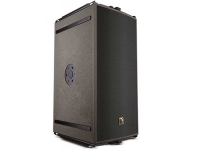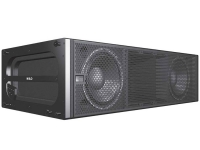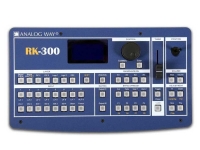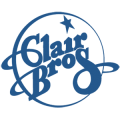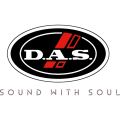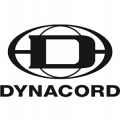ABOUT THE PRODUCT
ABOUT THE MANUFACTURER
GLOSSARY
MILO : High-Power Curvilinear Array Loudspeaker
MILO is a self-powered, four-way loudspeaker designed for vertical curvilinear arraying. It has ample power reserves (140 dB SPL peak output at 1 meter) for high output level, longer throw applications in large venues, yet its weight and cabinet dimensions allow for its use in more compact spaces.
MILO was designed to easily integrate with other Meyer Sound loudspeakers, particularly the M3D line array, M3D-Sub directional subwoofer, M2D compact curvilinear array and the CQ-2 full-range narrow coverage loudspeaker. Though substantially smaller than the M3D/M3D-Sub in height and depth, MILO shares the same width for seamless integration. When MILO arrays also include M3D-Subs, the combination exhibits dramaticly attenuated off-axis low-frequency response. This allows system designers to configure arrays that effectively steer bass energy away from areas located behind the arrays, such as the stage and monitor mix position, where minimum levels are desired.
The MILO low/low-mid section comprises two neodymium magnet 12-inch cone drivers with 4-inch voice coils. These drivers function in a two-way arrangement, with both drivers active below 300 Hz for maximum low frequency impact. Above 300 Hz, an integral crossover rolls off one driver to maintain optimal polar and frequency response.
The mid-high section uses a 4-inch diaphragm (1.5-inch exit) compression driver coupled to a 90° constant directivity horn through Meyer Sound’s REM ribbon emulation manifold (patent pending). REM produces a wave front similar to that of a ribbon driver, but allows the far higher output generated by a compression driver. A dedicated very-high frequency section, with extended range to 18 kHz, employs three 2-inch diaphragm (0.75-inch exit) compression drivers coupled via a second REM to a 90° horn.
All MILO transducers are designed and manufactured in-house by Meyer Sound, and are driven by an on-board, four-channel class AB/H amplifier that provides more than 3935 watts of total output power. The integrated amplifier/processing circuitry includes TruPower* limiting to protect the drivers and hold long-term power compression to less than 1 dB. The field-replaceable electronics module incorporates Meyer Sound’s Intelligent AC power supply, which automatically adjusts for any line voltage worldwide and provides both soft turn-on and transient protection.
Meyer Sound’s RMS monitoring system interface is fitted as standard on MILO. RMS allows engineers to monitor and troubleshoot all key operating parameters on each MILO – as well as any other RMS-equipped Meyer Sound cabinets – from a remote Windows-based computer.
MILO systems may be deployed in either flown or ground-stacked configurations. Captive QuickFly rigging hardware uses rigid AlignaLinks for coupling the units, and allows nine splay angles between 0° and 5°. The rigid connections make for easy adjustment of array tilt, and often eliminate the need for a pullback strap in flown configurations. An optional MG-3D/M multipurpose grid accommodates a variety of flown or stacked configurations, including multipoint support and bridles. A single flown array can include up to 24 MILO loudspeakers, or the equivalent weight of MILOs, M3Ds, M3D-Subs, M2Ds, CQ-2s and rigging hardware. Stacking no more than six cabinets is advised.
With its unique combination of high power and compact size, MILO can serve as the key component in scalable, building block systems comprising any or all M Series products and certain other Meyer Sound models. MILO can be combined with the M3D for very large venue applications, or transition to M2D or CQ-2 loudspeakers for near field coverage where appropriate.
A weather-protected version with a folding rain hood that safeguards the electronics is optionally available.
*TruPower limiting protects loudspeaker components without compromising performance. TruPower monitors real-time power consumption, incorporating the impedance of the transducer into its calculation. The result is an accurate estimation of voice coil temperature, affording greater long-term protection, while eliminating excess compression.
Features & Benefits
- Extremely high power-to-size ratio for lower costs and flexible installation
- Exceptional fidelity and peak capability assure clean, high-impact response
- Seamless integration with other M Series models
- QuickFly rigging system simplifies use in flown or ground-stacked arrays
Applications
- Stadiums, arenas, concert halls and theatres
- Touring sound reinforcement
- Large-scale events
Professional used lighting equipment.| Professional second hand lighting equipment.| Professional pre owned lighting equipment.
Professional used audio equipment.| Professional second hand audio equipment.| Professional pre owned audio equipment.
Second hand audio gear. | Second hand lighting.
Pro audio equipment, second hand amplifiers, DJ, second hand sound systems, second hand Microphones, second hand Media Players.
Outdoor & Indoor LED screens for sale, LED mobile truck.
Light trussing, Gebrauchte Veranstaltungstechnik, used stage equipment Stage & Theatre lighting products.
Used Meyer Sound Laboratories
Meyer Sound Laboratories is an American company based in Berkeley, California that manufactures self-powered loudspeakers, multichannel audio show control systems, electroacoustic architecture, and audio analysis tools for the professional sound reinforcement, fixed installation, and sound recording industries.
The company’s emphasis on research and measurement has resulted in the issuance of dozens of patents, including for the now-standard trapezoidal loudspeaker cabinet shape. Meyer Sound has pioneered other technologies that have become standard in the audio industry, including: processor-controlled loudspeaker systems, self-powered loudspeakers,curvilinear arraying, cardioid subwoofers, and source independent measurement.
Meyer Sound has consistently involved itself with advanced research beyond that connected to immediate product development, sometimes in conjunction with arms of the University of California, Berkeley. Some of this research has resulted in unusual products such as their parabolic sound beam and sound field synthesis loudspeakers. Other projects, such as the spherical loudspeaker research underway by Meyer Sound and CNMAT (Center for New Music and Audio Technologies) at UC Berkeley are still in the stage of pure research.
Professional used lighting equipment.| Professional second hand lighting equipment.| Professional pre owned lighting equipment.
Professional used audio equipment.| Professional second hand audio equipment.| Professional pre owned audio equipment.
Second hand audio gear. | Second hand lighting.
Pro audio equipment, second hand amplifiers, DJ, second hand sound systems, second hand Microphones, second hand Media Players.
Outdoor & Indoor LED screens for sale, LED mobile truck.
Light trussing, Gebrauchte Veranstaltungstechnik, used stage equipment Stage & Theatre lighting products.
Efficiency Rating: Level of sound output measured at a prescribed distance with a standard input power. Efficiency rating standard is 1 watt (2.83V at 8 ohms) at 1 meter over a specified frequency range and is measured in decibels.
Equalization: Loosely, any type of relative frequency adjustment. Specifically, the process of changing the frequency balance of an electrical signal to alter the acoustical output.
Equalizer: A component designed to alter the frequency balance of an audio signal. Equalizers may be graphic, parametric, or a combination of both.
Fade: A gradual increase in audio, i.e. a fade-up, or a gradual decrease in audio, i.e. a fade-down.
Feedback: The transmission of current or voltage from the output of a device back to the input, where it interacts with the input signal to modify operation of the device. Feedback is positive when it’s in phase with the input and negative when it’s out of phase.
FM: Frequency Modulated.
Frequency: The number of cycles (vibrations) per second. In audio, audible frequencies commonly range from 20 to 20,000 cycles per second (Hz). In video, frequency is used to define the image resolution. Low-frequency video images depict large objects or images. Higher frequencies depict smaller objects (finer details.
Frequency Response: A measure of what frequencies can be reproduced and how accurately they are reproduced. A measurement of 20 to 20,000 Hz, 3dB means those frequencies between 20 and 20,000 Hz can be reproduced no more than 3 dB above or below a reference frequency level.
Full-Range: A speaker designed to reproduce the full range (20 Hz to 20 kHz) of audio frequencies.
Gain: Increase in level or amplitude.
Gooseneck: This refers to a microphone with a flexible neck that is most frequently attached to a podium or lectern. It is designed to allow the speaker to raise or lower the microphone to a suitable height.
Graphic Equalizer: A type of equalizer with sliding controls that creates a pattern representing a graph of the frequency-response changes. Raising sliders boosts the affected frequencies lowering sliders cuts (attenuates) the affected frequencies.
HDCP: High-Bandwidth Digital Content Protection. Created by Intel, HDCP is used with HDTV signals over DVI and HDMI connections and on D-Theater D-VHS recordings to prevent unauthorized duplication of copyright material.
HDR: Hard-Drive Recorder. Device that uses a computer hard drive to store compressed digital audio and video signals.
High Pass: A filter that passes high frequencies, and attenuates low frequencies. Same as low cut.
Hz: Hertz or cycles per second. Something that repeats a cycle once each second moves at a rate of 1 Hz.
Incue/Inq/In-Point: These words all refer to the initial few seconds of audio signifying the beginning of the production.
Integrated Amplifier: A combination preamp and amplifier.
Impedance: A measure of the impediment to the flow of alternating current, measured in ohms at a given frequency. Larger numbers mean higher resistance to current flow.
KHz: Kilohertz or one thousand Hz.
Lavaliere: A small microphone that attaches to clothing, allowing the speaker to have a hands-free presentation.
Line Array: A group of speakers that have been arrayed or "built up" in the vertical or horizontal plane, which allow for a highly consistent sound field. A Line Array is perfect for medium to large audiences.
Line-Level (Low-Level): A level of electrical signals too low to make the average speaker move sufficiently. Amplifiers receive line-level signals and amplify them to speaker level.
lockout: The final words of a segment used to signify the production’s conclusion.
Low Pass: A filter that lets low frequencies go through but doesn’t let high frequencies go through. Same as high cut.
MHz: Megahertz, or 1 million Hz.
Midbass: The middle of the bass part of the frequency range, from approximately 50 to 100 Hz (upper bass would be from 100 to 200 Hz). Also used as a term for loudspeaker drivers designed to reproduce both bass and midrange frequencies.
Midrange: The middle of the audio frequency range. Also used as a term for loudspeaker drivers designed to reproduce this range.
Mixer: This is the unit in which audio signals are directed from. A mixer provides for both mic and line input combinations while allowing you to control one or more outputs.
MLP: Meridian Lossless Packing. Encoding format that is able to completely reconstruct the original signal at the receiving end. No information is lost or discarded, regardless of how trivial it might be. Used to encode six channels of high-resolution audio on DVD-A.
Mono: Monophonic sound. One channel.
MP3: MPEG-1 Audio Layer-3. Compression scheme used to transfer audio files via the Internet and store in portable players and digital audio servers.
Natural Sound (NATS): The nonverbal audio that occurs in a non-studio setting. NATS can be used to help characterize the setting.
Noise: An unwanted portion of a signal such as hiss, hum, whine, static, or buzzing.
Nonlinear Editing: Digital audio systems that allow for clips to be extracted without affecting the master recording.
Professional used lighting equipment.| Professional second hand lighting equipment.| Professional pre owned lighting equipment.
Professional used audio equipment.| Professional second hand audio equipment.| Professional pre owned audio equipment.
Second hand audio gear. | Second hand lighting.
Pro audio equipment, second hand amplifiers, DJ, second hand sound systems, second hand Microphones, second hand Media Players.
Outdoor & Indoor LED screens for sale, LED mobile truck.
Light trussing, Gebrauchte Veranstaltungstechnik, used stage equipment Stage & Theatre lighting products.

